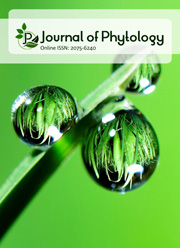Sourcing antimicrobial agents from Globimetula braunii: An in silico molecular docking and dynamic approach
DOI:
https://doi.org/10.25081/jp.2024.v16.8850Keywords:
Globimetula braunii, Molecular docking, Molecular dynamics, Antimicrobials, 13,27-cyycloursan-3-oneAbstract
The continued emergence of multi-drug resistance pathogens has been a major setback to lifting the burden of infectious diseases, especially bacterial illnesses. Natural- and/or nature-inspired compounds have so far become a therapeutic backbone on which many novel antibacterial agents are optimized. It is against this backdrop that we used an in silico molecular interaction-based approach to screen five previously identified compounds from Globimetula braunii, for lead inhibitors against bacterial illnesses. The compounds were chromatographed from the leaf ethyl acetate fraction and were characterized by spectroscopic means as 13,27-cycloursane (1), 13,27-cycloursan-3-one (2), methyl-3,5-dihydroxy-4-methoxybenzoate (3), 3-methyl-4-hydroxybenzoate (4), and 2-methoxyphenol (5). Upon their molecular docking at the active pocket of the Staphylococcus aureus gyrase B and the Escherichia coli DNA gyrase, 2 showed the highest binding affinities, with energy scores of -10 and -9.6 Kcal/mol. These were better than the standard antibiotics, Ampicillin (-7.5 and -8.0 Kcal/mol), and Ciprofloxacin (-6.9, -8.4 Kcal/mol). Further evaluation of the most promising compound 2 by molecular dynamics simulation showed the mean RMSD values of the 13,27-cycloursan-3-one - E. coli DNA gyrase protein complexes (complex 1) and 13,27-cycloursan-3-one - S. aureus gyrase B protein (complex 2) to be 0.7 and 0.9 Ǻ respectively, attaining stability at 102 and 108 ns. In contrast, complexes 1 and 2’s RMSF analysis revealed the fewest fluctuations and was generally stable over the course of the 120 ns. In conclusion, 13,27-cycloursan-3-one is unquestionably the most promising inhibitory candidate against the bacterial growth protein DNA gyrase, hence, it can be considered as a druggable substance against bacterial disease.
Downloads
References
Abraham, M. J., Murtola, T., Schulz, R., Páll, S., Smith, J. C., Hess, B., & Lindahl, E. (2015). GROMACS: High performance molecular simulations through multi-level parallelism from laptops to supercomputers. SoftwareX, 1, 19-25. https://doi.org/10.1016/j.softx.2015.06.001
Baker, C., Pradhan, A., Pakstis, L., Pochan, D. J., & Shah, S. I. (2005). Synthesis and antibacterial properties of silver nanoparticles. Journal of Nanoscience & Nanotechnology, 5(2), 244-249. https://doi.org/10.1166/jnn.2005.034
Beveridge, T. J., & Fyfe, W. S. (1985). Metal fixation by bacterial cell walls. Canadian Journal of Earth Sciences, 22(12), 1893-1898. https://doi.org/10.1139/e85-204
Broeck, A. V., Lotz, C., Ortiz, J., & Lamour, V. (2019). Cryo-EM structure of the complete E. coli DNA gyrase nucleoprotein complex. Nature Communications, 10(1), 4935. https://doi.org/10.1038/s41467-019-12914-y
Eakin, A. E., Green, O., Hales, N., Walkup, G. K., Bist, S., Singh, A., Mullen, G., Bryant, J., Embrey, K., Gao, N., Breeze, A., Timms, D., Andrews, B., Uria-Nickelsen, M., Demeritt, J., Loch III, J. T., Hull, K., Blodgett, A., Illingworth, R. N., ... Sherer, B. (2012). Pyrrolamide DNA gyrase inhibitors: fragment-based nuclear magnetic resonance screening to identify antibacterial agents. Antimicrobial Agents & Chemotherapy, 56(3), 1240-1246. https://doi.org/10.1128/AAC.05485-11
Elfiky, A. A., & Azzam, E. B. (2020). Novel guanosine derivatives against MERS CoV polymerase: An in silico perspective. Journal of Biomolecular Structure & Dynamics, 39(8), 2923-2931. https://doi.org/10.1080/07391102.2020.1758789
Enayatkhani, M., Hasaniazad, M., Faezi, S., Guklani, H., Davoodian, P., Ahmadi, N., Einakian, M. A., Karmostaji, A., & Ahmadi, K. (2020). Reverse vaccinology approach to design a novel multi-epitope vaccine candidate against COVID-19: An in silico study. Journal of Biomolecular Structure and Dynamics, 39(8), 2857-2872. https://doi.org/10.1080/07391102.2020.1756411
Flores-López, N. S., Cortez-Valadez, M., Moreno-Ibarra, G. M., Larios-Rodríguez, E., Torres-Flores, E. I., Delgado-Beleño, Y., Martinez-Nuñez, C. E., Ramírez-Rodríguez, L. P., Arizpe-Chávez, H., Castro-Rosas, J., Ramirez-Bon, R., & Flores-Acosta, M. (2016). Silver nanoparticles and silver ions stabilized in NaCl nanocrystals. Physica E: Low-dimensional Systems Nanostructures, 84, 482-488. https://doi.org/10.1016/j.physe.2016.07.012
Halliwell, B., & Gutteridge, J. M. C. (1981). Formation of a thiobarbituric acid reactive substance from deoxyribose in the presence of iron salts. FEBS Letter, 128(2), 347-352. https://doi.org/10.1016/0014-5793(81)80114-7
Jiang, X., Kumar, K., Hu, X., Wallqvist, A., & Reifman, J. (2008). DOVIS 2.0: an efficient and easy to use parallel virtual screening tool based on AutoDock 4.0. Chemistry Central Journal, 2, 18. https://doi.org/10.1186/1752-153X-2-18
Kar, P., Kumar, V., Vellingiri, B., Sen, A., Jaishee, N., Anandraj, A., Malhotra, H., Bhattacharya, S., Mukhopadhyay, S., Kinoshita, M., Govindasamy, V., Roy, A., Naidoo, D., & Subramaniam, M. D. (2022a). Anisotine and amarogentin as promising inhibitory candidates against SARS-CoV-2 proteins: a computational investigation. Journal of Biomolecular Structure and Dynamics, 40(10), 4532-4542. https://doi.org/10.1080/07391102.2020.1860133
Kar, P., Saleh‐E‐In, M. M., Jaishee, N., Anandraj, A., Kormuth, E., Vellingiri, B., Angione, C., Rahman, P. K. S. M., Pillay, S., Sen A., Naidoo, D., Roy, A., & Choi, Y. E. (2022b). Computational profiling of natural compounds as promising inhibitors against the spike proteins of SARS‐CoV‐2 wild‐type and the variants of concern, viral cell‐entry process, and cytokine storm in COVID‐19. Journal of Cellular Biochemistry, 123(5), 964-986. https://doi.org/10.1002/jcb.30243
Kar, P., Sharma, N. R., Singh, B., Sen, A., & Roy, A. (2021). Natural compounds from Clerodendrum spp. as possible therapeutic candidates against SARS-CoV-2: An in silico investigation. Journal of Biomolecular Structure and Dynamics, 39(13), 4774-4785. https://doi.org/10.1080/07391102.2020.1780947
Lu, J., Patel, S., Sharma, N., Soisson, S. M., Kishii, R., Takei, M., Fukuda, Y., Lumb, K. J., & Singh, S. B. (2014). Structures of kibdelomycin bound to Staphylococcus aureus GyrB and ParE showed a novel U-shaped binding mode. ACS Chemical Biology, 9(9), 2023-2031. https://doi.org/10.1021/cb5001197
Muhammad, K. J., Jamil, S., Basar, N., Arriffin, N. M., Idris, M. T., Jibril, S., & Akanji, F. T. (2022). Antioxidant, antimicrobial and antityrosinase activities of phytochemicals from the leaves of Globimetula braunii (Engler) Van Tiegh (Loranthaceae). Bulletin of the Chemical Society of Ethiopia, 36(2), 387-397. https://doi.org/10.4314/bcse.v36i2.12
Muhammad, K. J., Jamil, S., Basar, N., Sarker, S. D., & Mohammed, M. G. (2020). Globrauneine A–F: six new triterpenoid esters from the leaves of Globimetula braunii. Natural Product Research, 34(19), 2746-2753. https://doi.org/10.1080/14786419.2019.1586693
Naidoo, D., Roy, A., Kar, P., Mutanda, T., & Anandraj, A. (2020). Cyanobacterial metabolites as promising drug leads against the Mpro and PLpro of SARS-CoV-2: An in silico analysis. Journal of Biomolecular Structure & Dynamics, 39(16), 6218-6230. https://doi.org/10.1080/07391102.2020.1794972
Oriola, A. O., Aladesanmi, A. J., Idowu, T. O., Akinwumi, F. O., Obuotor, E. M., Idowu, T., & Oyedeji, A. O. (2021). Ursane-type triterpenes, phenolics and phenolic derivatives from Globimetula braunii leaf. Molecules, 26(21), 6528. https://doi.org/10.3390/molecules26216528
Paterson, D. L., & van Duin, D., (2017). China's antibiotic resistance problems. Lancet Infectious Diseases, 17(4), 351-352. https://doi.org/10.1016/s1473-3099(17)30053-1
Reece, R. J., & Maxwell, A. (1991). DNA gyrase: structure and function. Critical Reviews in Biochemistry and Molecular Biology, 26(3-4), 335-375. https://doi.org/10.3109/10409239109114072
Salentin, S., Schreiber, S., Haupt, V. J., Adasme, M. F., & Schroeder, M. (2015). PLIP: fully automated protein-ligand interaction profiler. Nucleic Acids Research, 43(W1), W443-W447. https://doi.org/10.1093/nar/gkv315
Schüttelkopf, A. W., & van Aalten, D. M. F. (2004). PRODRG: a tool for high-throughput crystallography of protein–ligand complexes. Acta Crystallographica Section D: Biological Crystallography, 60(8), 1355-1363. https://doi.org/10.1107/s0907444904011679
Trott, O., & Olson, A. J. (2010). AutoDock Vina: Improving the speed and accuracy of docking with a new scoring function, efficient optimization, and multithreading. Journal of Computational Chemistry, 31(2), 455-461. https://doi.org/10.1002/jcc.21334
Umesh, Kundu, D., Selvaraj, C., Singh, S. K., & Dubey, V. K. (2020). Identification of new anti-nCoV drug chemical compounds from Indian spices exploiting SARS-CoV-2 main protease as target. Journal of Biomolecular Structure and Dynamics, 39(9), 3428-3434. https://doi.org/10.1080/07391102.2020.1763202
Published
How to Cite
Issue
Section
Copyright (c) 2024 Ayodeji O. Oriola, Pallab Kar, Adebola O. Oyedeji

This work is licensed under a Creative Commons Attribution 4.0 International License.





 .
.